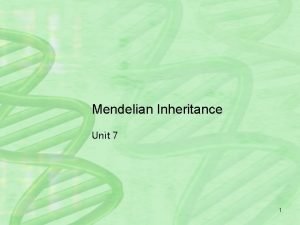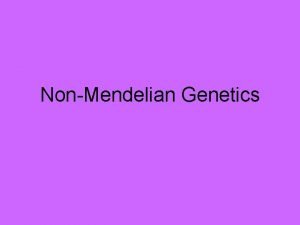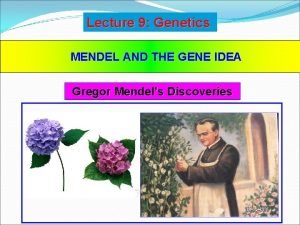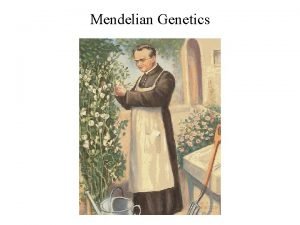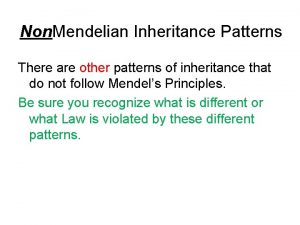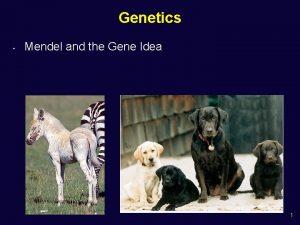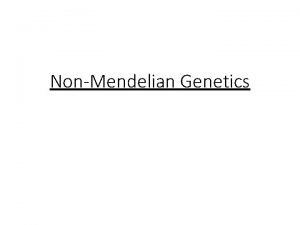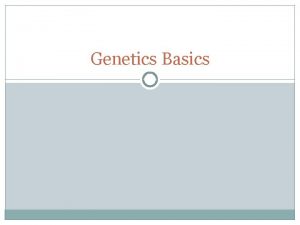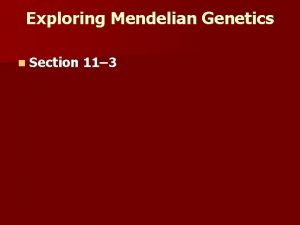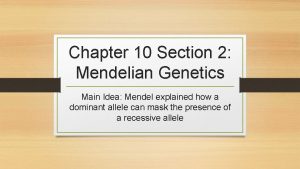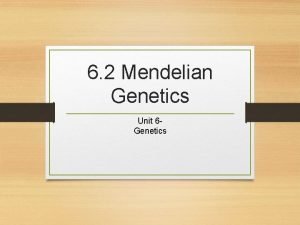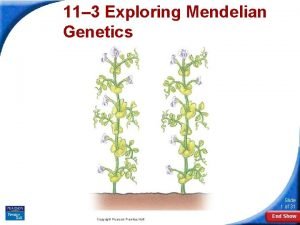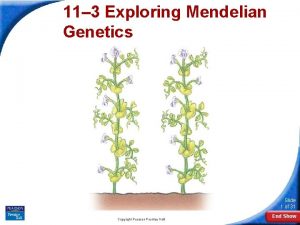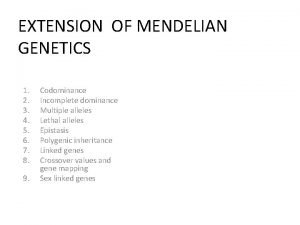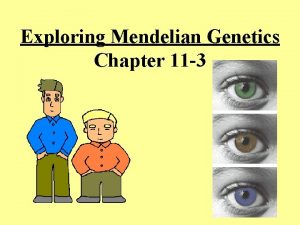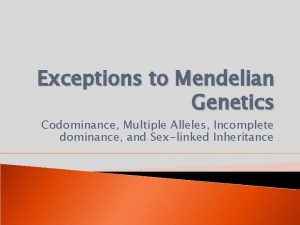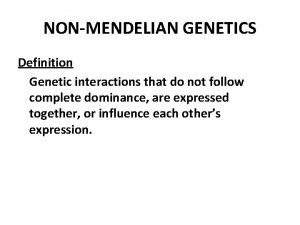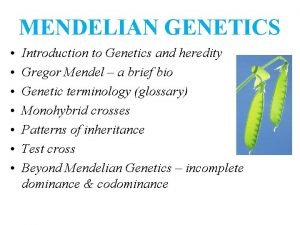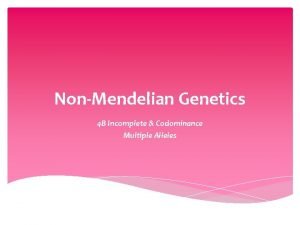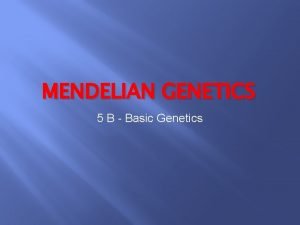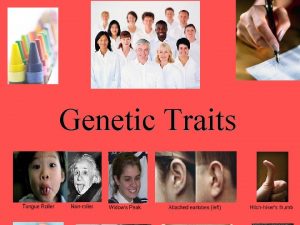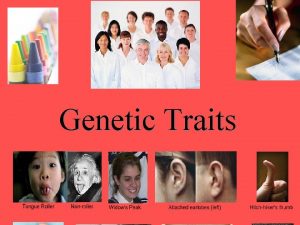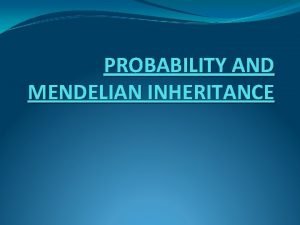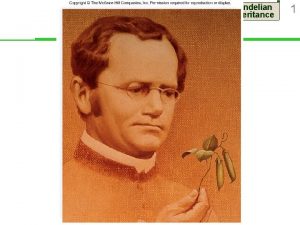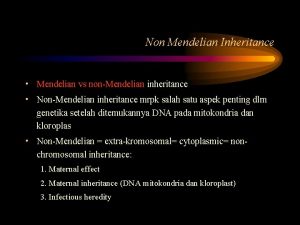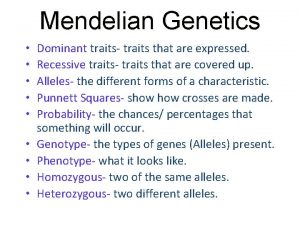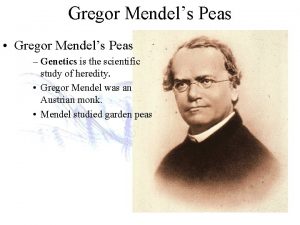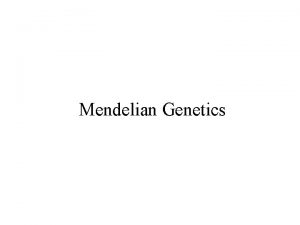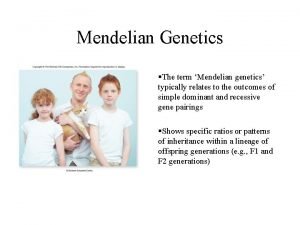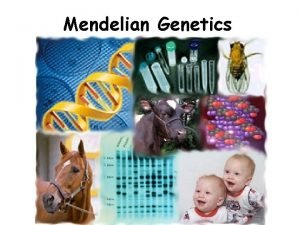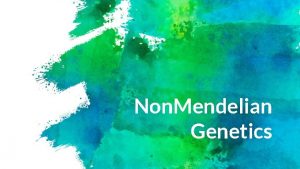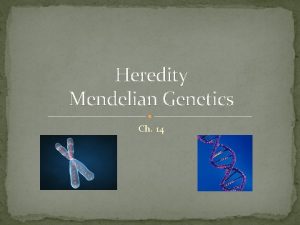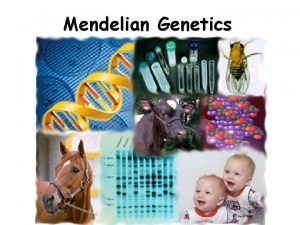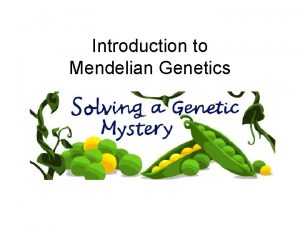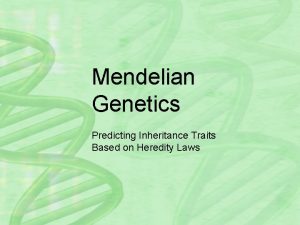Mendelian Genetics inheritance of traits Why Peas Many


























- Slides: 26

Mendelian Genetics – inheritance of traits

Why Peas? ? ü Many varieties (character, traits) ü Easy to control pollination ü Could choose distinct characters

First Experiments: True-breeding parent generation Why aren’t all the floweres light purple?

Mendel’s Law of Segregation White “heritable factor” did not disappear in F 1 generation but only purple “heritable factor” was acting. Ø Alternative version of genes (heritable factors) account for variations in inherited characters. ØFor each character, an organism inherits two alleles (versions of the gene) one from each parent. ØIf the two alleles differ, one is fully expressed – DOMINANT; the other does not affect the organism’s appearance - RECESSIVE trait. ØThe two alleles segregate during gamete production

Mendelian Genetics Terms • • Homozygous Heterozygous Phenotype Genotype Punnett square Monohybrid cross Testcross

Testcross

What happens if looking at two traits simultaneously? • Dihybrid cross True-breeding Parent (P) F 1 F 2: 9: 3: 3: 1 x


Mendel’s Law of Independent Assortment • Each character is independently inherited – segregate independently during gamete formation • Practice dihybrid crosses • Use rules of probability to predict outcomes of genetic crosses

http: //www. biology. arizona. edu/me ndelian_genetics/problem_sets/mo nohybrid_cross/monohybrid_cross. html

More Complicated Situations… 1. Incomplete dominance

Multiple Alleles IAIA = A; IAi = A IAIB= AB ii = O IBIB=B; IBi = B A, B – codominant i - recessive

Other situations: • Pleiotropy – one gene affects several phenotypes • Epistasis – one gene affects the phenotypic expression of another gene • Polygenetic inheritance – additive effect of two or more genes on a single phenotypic character


Human Disorders that follow Mendelian Patterns of Inhertitance • Recessively inherited disorders: albinism, cystic fibrosis, Tay-Sachs disease, sickle-cell anemia • Dominantly inherited disorders: Achondroplasia, Huntington’s disease

Cystic Fibrosis

Tay-Sachs Disease

Achondroplasia

Huntington Disease Late Acting – middle age Western Europeans


Screening for inherited disorders

Pedigrees

Pedigree – Huntington disease

Pedigree – Sickle cell anemia

Chromosomal Theory of Inheritance Thomas Morgan Fruitflies 4 pairs of chromosomes Wild type phenotype Mutant phenotype White-eyed males only

Sex-linked traits Located on Sex chromosomes: X or Y Females XX; Males XY X-linked recessive Hemophilia, color blindness
 Difference between mendelian and non mendelian inheritance
Difference between mendelian and non mendelian inheritance Non mendelian inheritance
Non mendelian inheritance Cystic fibrosis mendelian inheritance
Cystic fibrosis mendelian inheritance Probability laws govern mendelian inheritance
Probability laws govern mendelian inheritance Mendelian pattern of inheritance
Mendelian pattern of inheritance Mendel experiments in plant hybridization
Mendel experiments in plant hybridization Mendelian inheritance pattern
Mendelian inheritance pattern Mendel's experimental design
Mendel's experimental design Codominance
Codominance Section 11-5 linkage and gene maps answer key
Section 11-5 linkage and gene maps answer key Mendelian traits
Mendelian traits Chapter 7 extending mendelian genetics study guide answers
Chapter 7 extending mendelian genetics study guide answers Section 11-3 exploring mendelian genetics
Section 11-3 exploring mendelian genetics Chapter 10 section 2: mendelian genetics
Chapter 10 section 2: mendelian genetics Mendelian genetics punnett square
Mendelian genetics punnett square 11-3 exploring mendelian genetics
11-3 exploring mendelian genetics 11-3 exploring mendelian genetics answers
11-3 exploring mendelian genetics answers Karyotype
Karyotype Extension of mendelian genetics
Extension of mendelian genetics Section 11-3 exploring mendelian genetics
Section 11-3 exploring mendelian genetics Hors xnxn
Hors xnxn Identify the disorder
Identify the disorder Define pleiotropic gene
Define pleiotropic gene Codominance
Codominance Pedigree miscarriage symbol
Pedigree miscarriage symbol The scientific study of heredity *
The scientific study of heredity * Codominance alleles
Codominance alleles
